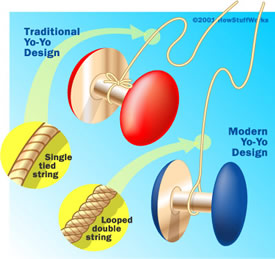
So how does a yo-yo work? Why is it so popular among physicists? "To a physicist... a yo-yo is a remarkably fun example of a flywheel," said Gordon Jones, assistant professor of physics at Hamilton College1. When the yo-yo is held, it has a certain amount of potential energy. It has the potential to fall as well as the potential to spin due to the string. As the yo-yo falls, the potential energy changes to kinetic energy as it builds up an amount of linear momentum and angular momentum. Due to the angular momentum, the yo-yo will keep spinning once it reaches the end of the string.
In the original model of yo-yo, where the string is tied tightly to the axle, the yo-yo will automatically start to climb back up the string due to gyroscopic stability. However, the person holding the end of the string will have to give it a slight tug in order to get the yo-yo to climb all the way back to its original position because of the energy lost due to friction.
In today's model, the string is only looped around the axle, so once the yo-yo reaches the end of the string it will not automatically climb back up. Instead, it will sit at the bottom and spin in what is called the "sleeping" position. To learn about the physics of yo-yo tricks, click here.

-
History | Formula | Glossary | Bibliography | Home


